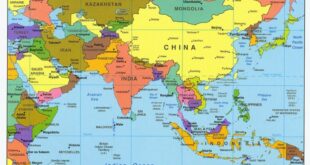The US is more hands-off than usual in the Middle East. It fears making things worse. This shift in strategy comes after decades of direct involvement, marked by both successes and failures. The region is now a complex web of conflicts, economic challenges, and shifting alliances, making it difficult for the US to maintain its traditional role as a dominant force.
This cautious approach raises questions about the future of US influence in the region and its impact on global stability.
The US’s reluctance to intervene stems from a combination of factors. The costly and often controversial wars in Iraq and Afghanistan have left many Americans wary of further military entanglements. The rise of regional powers like Iran and Turkey has also challenged US dominance.
Furthermore, the internal struggles within countries like Syria and Yemen have highlighted the limitations of external intervention.
Historical Context
The US involvement in the Middle East has been a long and complex process, marked by periods of both intense engagement and relative disengagement. The region’s strategic importance, coupled with its abundant oil reserves, has driven US interest for decades, resulting in a dynamic relationship characterized by interventions, alliances, and diplomatic efforts.The US involvement in the Middle East has been shaped by a number of factors, including the Cold War, the rise of Islamic extremism, and the pursuit of energy security.
The Cold War era saw the US vying for influence with the Soviet Union, leading to alliances with regional powers like Saudi Arabia and Israel. The emergence of Islamic extremism in the 1980s and 1990s further heightened US engagement, culminating in the wars in Afghanistan and Iraq.
US Interventions in the Middle East
The US has intervened in the Middle East on numerous occasions, with varying degrees of success. These interventions have been driven by a range of motives, including the desire to protect US interests, promote democracy, and counter terrorism. Here are some notable examples:
- The 1991 Gulf War: This conflict was triggered by Iraq’s invasion of Kuwait. The US, leading a coalition of international forces, launched a military campaign to liberate Kuwait. The war was successful in achieving its objectives, but it also led to the rise of Islamic extremism in Iraq.
- The 2003 Invasion of Iraq: This invasion was based on the US government’s claim that Iraq possessed weapons of mass destruction. The war ultimately led to the overthrow of Saddam Hussein’s regime, but it also destabilized the region and contributed to the rise of the Islamic State of Iraq and Syria (ISIS).
- The War in Afghanistan: This conflict began in 2001 following the September 11th attacks, which were carried out by al-Qaeda, a terrorist group operating in Afghanistan. The US, along with its allies, launched a military campaign to remove the Taliban regime from power and dismantle al-Qaeda.
The war has been long and costly, with no clear end in sight.
These interventions have had both positive and negative consequences for the Middle East. While some interventions have contributed to stability and democracy, others have led to increased instability and conflict. The long-term effects of US involvement in the region are still being debated.
Current Dynamics
The US’s more hands-off approach in the Middle East is driven by a complex interplay of factors, including domestic political pressures, a shift in strategic priorities, and the evolving geopolitical landscape. This shift has implications for the region’s stability, security, and future trajectory.
Key Factors Driving the US’s Hands-Off Approach
The US’s more hands-off approach is driven by a number of key factors:
- Domestic Political Pressures:The US public has become increasingly weary of prolonged military interventions abroad, especially in the Middle East. The wars in Iraq and Afghanistan have been costly in terms of both lives and resources, leading to a growing desire for a less interventionist foreign policy.
- Shift in Strategic Priorities:The US has increasingly focused on countering China’s rise and the growing threat of Russia. This shift in strategic priorities has led to a re-allocation of resources and attention away from the Middle East.
- Evolving Geopolitical Landscape:The Middle East has become more complex and less amenable to US influence. The rise of non-state actors, such as ISIS, and the growing influence of regional powers, such as Iran and Turkey, have challenged the US’s ability to shape events in the region.
- Regional Instability:The ongoing conflicts in Syria, Yemen, and Libya have demonstrated the difficulty and potential for unintended consequences of US military intervention. The US has become more hesitant to intervene in these conflicts, fearing that it could make the situation worse.
Current Political Landscape in the Middle East
The Middle East is characterized by a complex and volatile political landscape, with a mix of authoritarian regimes, fragile democracies, and ongoing conflicts. These factors have significant implications for US policy:
- Authoritarian Regimes:Many countries in the Middle East are ruled by authoritarian regimes that are resistant to US influence and often pursue policies that are at odds with US interests.
- Fragile Democracies:The transition to democracy in many Middle Eastern countries has been fraught with challenges, including political instability, economic hardship, and sectarian tensions.
- Ongoing Conflicts:The Middle East is home to a number of ongoing conflicts, including the Syrian Civil War, the Yemeni Civil War, and the Israeli-Palestinian conflict. These conflicts have destabilized the region and created opportunities for extremist groups to flourish.
Perspectives on the US’s Role in the Middle East
Different stakeholders have different perspectives on the US’s role in the Middle East:
- Some argue that the US should continue to play a leading role in the region, citing its vital interests in maintaining stability and preventing the spread of extremism. They believe that the US has a responsibility to promote democracy and human rights in the region.
- Others argue that the US should adopt a more hands-off approach, believing that its past interventions have often been counterproductive and have destabilized the region. They believe that the US should focus on its own interests and allow regional powers to take the lead in resolving their own conflicts.
- Still others argue that the US should pursue a more nuanced approach, balancing its commitment to its interests with a recognition of the limits of its power and the need to engage with regional actors. They believe that the US should focus on diplomacy and economic development, while reserving military force for situations where vital interests are at stake.
Potential Consequences: The US Is More Hands-off Than Usual In The Middle East. It Fears Making Things Worse

The US’s more hands-off approach in the Middle East, while driven by a desire to avoid further entanglement, carries potential risks and benefits. This shift in strategy could impact regional stability, security, and economic development, while also influencing US interests and global power dynamics.
Impact on Regional Stability and Security
A less involved US could potentially destabilize the region. The US has historically played a significant role in mediating conflicts and deterring aggression, particularly in areas like the Israeli-Palestinian conflict and the Iran nuclear program. Without active US involvement, these conflicts could escalate, leading to increased violence and instability.
This could also create opportunities for regional powers like Iran and Turkey to expand their influence, potentially leading to new power dynamics and conflicts.
Impact on Economic Development
A US withdrawal could also negatively impact economic development in the region. The US has been a major investor in the Middle East, supporting infrastructure projects and promoting economic growth. A reduced US presence could discourage investment and hinder economic progress.
Additionally, the US has played a crucial role in ensuring the stability of oil markets, a critical factor for economic development in the region. A less involved US could lead to greater volatility in oil prices, impacting economies across the region.
Implications for US Interests and Global Power Dynamics
A less involved US could also weaken its strategic position in the Middle East. The US has maintained a significant military presence in the region for decades, providing security guarantees to allies and deterring adversaries. A reduced US presence could embolden adversaries like Iran and Russia, who might seek to fill the vacuum left by the US.
You also can investigate more thoroughly about Maddow Blog | MAGA members of Georgia election board advance another step in Trump’s election subversion scheme to enhance your awareness in the field of Maddow Blog | MAGA members of Georgia election board advance another step in Trump’s election subversion scheme.
This could also undermine US credibility and influence in the region, impacting its ability to advance its interests. Furthermore, a diminished US role in the Middle East could affect global power dynamics, potentially empowering regional powers and challenging the US’s global leadership.
Alternative Strategies
The US’s hands-off approach in the Middle East, while intended to minimize involvement, has raised questions about the effectiveness of this strategy. It’s crucial to explore alternative approaches that could potentially achieve greater stability and security in the region.
Increased Diplomatic Engagement
Increased diplomatic engagement could offer a more proactive approach to addressing regional conflicts. By fostering dialogue and cooperation, the US can encourage regional powers to find common ground and address their differences through peaceful means.
- Facilitating Dialogue:The US could play a more active role in mediating negotiations between conflicting parties, such as in the Israeli-Palestinian conflict, or in Yemen, where the US could work to bring together the warring factions.
- Strengthening Regional Organizations:Supporting regional organizations like the Arab League and the Gulf Cooperation Council could provide a platform for collective action and cooperation on issues of shared concern.
- Promoting Economic Cooperation:Facilitating economic partnerships and trade agreements could foster regional interdependence and reduce the potential for conflict.
This strategy’s feasibility depends on the willingness of regional actors to engage in dialogue and compromise. It could be hindered by deeply rooted mistrust and historical grievances. However, success could lead to more stable and cooperative relationships, reducing the need for military intervention.
Targeted Military Action, The US is more hands-off than usual in the Middle East. It fears making things worse
The US could adopt a more targeted approach to military intervention, focusing on specific threats like terrorism and state-sponsored aggression. This could involve precision strikes, drone operations, and limited deployments of special forces.
- Counter-Terrorism Operations:The US could continue to pursue counter-terrorism operations against groups like ISIS, but with a greater focus on building local capacity and intelligence sharing to ensure long-term stability.
- Deterring Aggression:The US could use its military power to deter aggressive actions by states like Iran, which could involve bolstering regional allies and deploying military assets in strategic locations.
- Humanitarian Interventions:The US could consider limited military interventions in situations of humanitarian crisis, such as in Syria, but with a clear exit strategy and a focus on building local capacity.
The effectiveness of this strategy depends on the specific targets and the ability to achieve desired outcomes without escalating conflicts. The potential for unintended consequences, such as civilian casualties or fueling anti-American sentiment, must be carefully considered.
Economic Development and Investment
Investing in economic development and infrastructure projects in the Middle East could create opportunities for growth and stability. This could include supporting local businesses, promoting entrepreneurship, and improving education and healthcare systems.
- Infrastructure Development:The US could partner with regional governments to invest in transportation, energy, and communication infrastructure, creating jobs and boosting economic activity.
- Private Sector Investment:The US could encourage private sector investment in the region, fostering economic growth and job creation. This could include providing financial incentives and streamlining regulatory processes.
- Education and Healthcare:Investing in education and healthcare systems could improve the quality of life for people in the region, fostering a more stable and prosperous future.
This strategy’s effectiveness depends on the commitment of regional governments to good governance and transparency. Corruption and mismanagement could undermine the positive impact of economic investments. However, successful economic development could create a more favorable environment for peace and stability.
Future Outlook
The US’s shift towards a more hands-off approach in the Middle East is a significant development with far-reaching implications. The long-term effects of this strategy are still unfolding, but it’s clear that the region will experience a period of transition and uncertainty.
The future of the Middle East will likely be shaped by a complex interplay of factors, including the changing dynamics of regional powers, the evolving role of the US, and the continued impact of internal conflicts and economic challenges.
Potential Future Scenarios
The US’s reduced involvement in the Middle East creates a vacuum that other regional actors are seeking to fill. This could lead to several potential future scenarios, each with its own set of consequences for the region:
- Increased Regional Competition:The US withdrawal could lead to increased competition between regional powers, such as Saudi Arabia, Iran, and Turkey, for influence and resources. This could result in a more unstable and unpredictable security environment.
- Emergence of New Power Centers:The US withdrawal could also create opportunities for the emergence of new power centers in the Middle East, such as the United Arab Emirates or Qatar. These countries could play a more active role in regional affairs, potentially shaping the political landscape.
- Renewed Focus on Internal Conflicts:The US withdrawal could lead to a renewed focus on internal conflicts within Middle Eastern countries, as regional powers and international actors seek to exploit opportunities or advance their interests. This could exacerbate existing tensions and lead to further instability.
Timeline of Key Events and Developments
The US’s shift in approach is part of a broader trend of reduced engagement in the Middle East. Here is a timeline of key events and developments that have contributed to this trend:
- 2003:The US-led invasion of Iraq marks the beginning of a period of intense involvement in the Middle East.
- 2011:The Arab Spring uprisings lead to regime change in several countries, including Egypt, Tunisia, and Libya. The US is criticized for its mixed response to these events.
- 2014:The rise of ISIS in Iraq and Syria leads to renewed US military intervention in the region.
- 2016:The election of Donald Trump as US President signals a shift in US foreign policy towards a more isolationist approach.
- 2019:The US withdraws from the Iran nuclear deal, leading to heightened tensions with Iran.
- 2020:The US brokered peace agreements between Israel and several Arab countries, including the United Arab Emirates and Bahrain. This signals a potential shift in regional alliances.
Final Wrap-Up
The US’s more hands-off approach in the Middle East is a significant departure from past policies. It reflects a growing recognition of the complexities of the region and the limitations of American power. While this shift may be necessary to avoid further entanglements, it also raises concerns about the potential for instability and the erosion of US influence.
The future of the Middle East remains uncertain, and the US’s role in shaping its destiny is likely to be more nuanced and less direct than in the past.
General Inquiries
What are the main reasons for the US’s more hands-off approach in the Middle East?
The US’s withdrawal from the Middle East is driven by several factors, including the costly and controversial wars in Iraq and Afghanistan, the rise of regional powers, and the recognition that external intervention often fails to solve complex internal conflicts.
What are the potential consequences of a less involved US in the Middle East?
A less involved US could lead to increased regional instability, a rise in extremism, and a decline in US influence. However, it could also allow for greater regional autonomy and potentially lead to more sustainable solutions to regional conflicts.
What alternative strategies could the US adopt in the Middle East?
The US could focus on diplomacy, economic engagement, and supporting regional initiatives to promote stability and cooperation. It could also work with allies to counter threats from extremist groups and regional rivals.
 CentralPoint Latest News
CentralPoint Latest News




